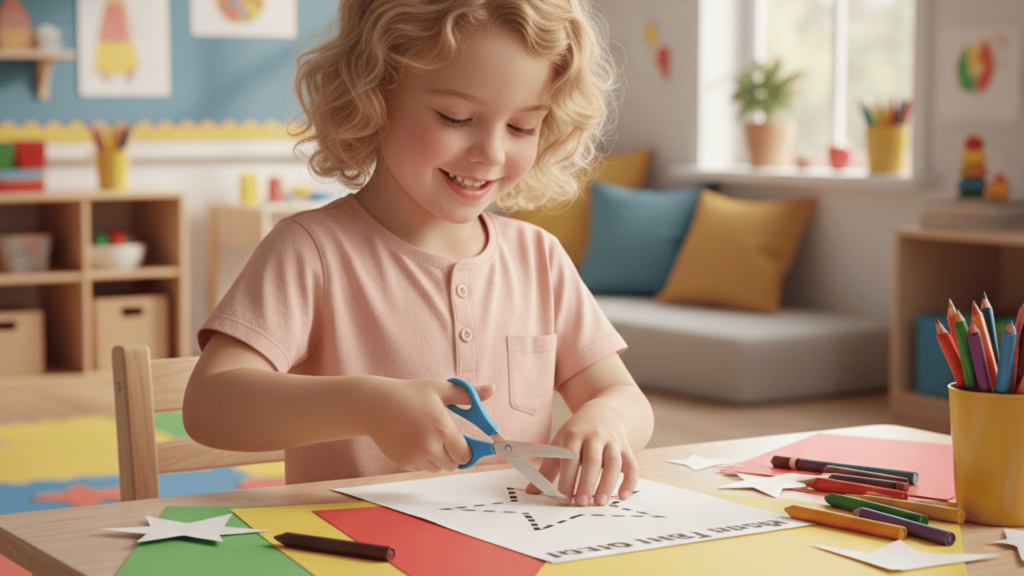I still remember the first time I handed my child a pair of safety scissors. There was a mix of excitement and hesitation, but what came next was a small moment that led to big growth.
Preschool cutting practice isn’t only about trimming paper; it’s about building patience, focus, and confidence that carry into so many parts of life. Each cut strengthens hand control, prepares little ones for writing, and even helps them feel more independent.
Today, I’ll show you that with the right mix of guidance and playful practice, kids can enjoy every step of the process. Let’s start by looking at why cutting practice matters before moving into simple ways to teach it.
Why Preschool Cutting Practice Matters
Cutting with scissors is more than just a fun preschool activity. It’s a key skill that helps kids get ready for bigger learning steps.
When children cut, they’re building fine motor skills. These small hand movements prepare them for writing, drawing, and even buttoning their clothes. I’ve seen how much steadier a child’s pencil grip gets once they practice scissor work.
Cutting also gives kids a sense of independence. Being able to handle scissors safely and complete simple tasks builds their confidence. In the classroom, these skills make it easier for them to keep up with group activities.
Developmental Stages of Scissor Skills
Every child develops at their own pace, but scissor skills usually grow in clear stages. Knowing these can help you see if your child is on track.
| Age | Cutting Skills | What to Expect |
|---|---|---|
| 3 years | Snipping and short lines | Can open and close scissors, make small cuts, and try short straight lines. |
| 4 years | Straight lines, curves, and basic shapes | Cuts across longer lines, follows simple curves, and begins cutting out shapes like circles or squares. |
| 5 years | Complex shapes and pictures | Handles zig-zags, jagged lines, and cuts around pictures with more control and accuracy. |
It’s essential to remember that progress appears differently for each child. Some pick it up quickly, while others need more time and encouragement.
Free Printable Worksheets: Preschool Cutting Pages
Worksheets are one of the easiest ways to get kids started with scissors. They give structure while keeping things fun.
Straight Lines, Curves, Zig-Zags
Start with simple sheets that have straight lines to cut across. Then move on to curves and zig-zags. These patterns strengthen hand control and prepare kids for harder tasks.
Shape-Based Worksheets
Once your child can handle lines, introduce basic shapes. Circles, squares, and triangles are perfect for this stage. Cutting out shapes helps with accuracy and builds patience.
Seasonal and Themed Worksheets
Holiday and animal-themed sheets keep practice exciting. Kids can cut pumpkins at Halloween, snowflakes in winter, or butterflies in spring. The themed designs keep them motivated and eager to try again.
With a mix of these worksheets, you’ll have a steady progression that feels more like play than practice.
How to Teach Cutting Step-by-Step
Teaching scissors skills takes a mix of patience and practice. I’ve found that kids learn best when the steps are simple and consistent.
1. Holding Scissors Correctly
Show your child how to place their thumb in the small hole and fingers in the larger one. Keep the thumb facing up and the elbow tucked close to the body. You can remind them with phrases like “thumbs up” to help it stick.
2. Teaching Safe Scissor Habits
Go over basic safety rules early.
- Always sit down while cutting.
- Keep scissors pointed away from the body.
- Only cut paper or craft materials, not clothes or hair.
These habits help kids feel confident while keeping everyone safe.
3. Common Mistakes to Avoid
Kids often flip the scissors upside down or grip them too tightly. Some may cut toward themselves instead of away. Watch for these signs and gently guide their hands back into the right position. A little correction early makes a big difference later.
Fun Cutting Activities Beyond Worksheets
Worksheets are great, but kids often enjoy hands-on activities even more. These simple ideas can keep practice fun while still building strong scissor skills:
- Cutting playdough, straws, and yarn: These materials are soft and forgiving, which makes them perfect for beginners. Snipping them builds hand strength without the frustration of tricky lines.
- Cutting for crafts: Try collages, paper chains, or simple decorations. I’ve noticed kids stay more focused when the cutting has a creative purpose.
- “Cutting trays” for classroom or home: A tray with pre-cut paper strips, shapes, or patterns gives kids a clear setup. You can rotate what’s inside to keep things fresh and exciting.
Mixing these activities with worksheets keeps practice balanced and engaging.
Tips for Struggling Kids
Some kids take to scissors right away, while others need more time. If cutting feels tough for your child, here are a few ways to help:
| Tip | What It Means | How It Helps |
|---|---|---|
| Signs of readiness | The child shows steady hand control, interest in crafts, and can open/close scissors. | Tells you if they’re ready to start cutting or if it’s best to wait. |
| Adaptive scissors | Tools like loop scissors or spring-loaded scissors. | Gives extra support for kids with weak grip or low hand strength. |
| Therapist strategies | Break tasks into steps, use thicker paper, or add hand-strengthening games. | Makes cutting less frustrating and easier to learn over time. |
The key is to celebrate small wins and let progress happen at the child’s pace.
Safety and Supervision Tips
Scissors can be safe when kids learn the basics. Here are a few things to keep in mind:
- Choosing age-appropriate scissors: Start with blunt-tip safety scissors and move to sharper ones only when your child is ready.
- Safe classroom/home setup: Give kids a flat, well-lit surface, keep supplies nearby, and store adult scissors out of reach.
- Teaching responsibility: Show kids how to carry scissors with blades closed, pass them handle-first, and treat them as tools, not toys.
These simple steps keep cutting practice safe and stress-free for both kids and adults.
Wrapping Up
Preschool cutting practice isn’t just about using scissors; it’s about giving children the chance to build confidence, focus, and patience through small steps that lead to bigger skills.
When you mix worksheets with real-life activities, kids see learning as fun instead of a chore. I’ve found that celebrating little wins, like cutting along a tricky curve, keeps motivation high and progress steady.
Every child moves at their own pace, so creating a supportive, low-pressure environment makes all the difference.
If you’re ready for more simple, practical ways to support your child’s early learning, check out my other helpful blogs for fresh ideas and guidance.











